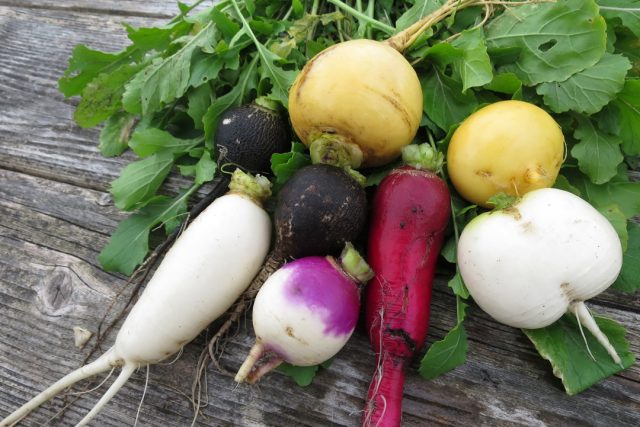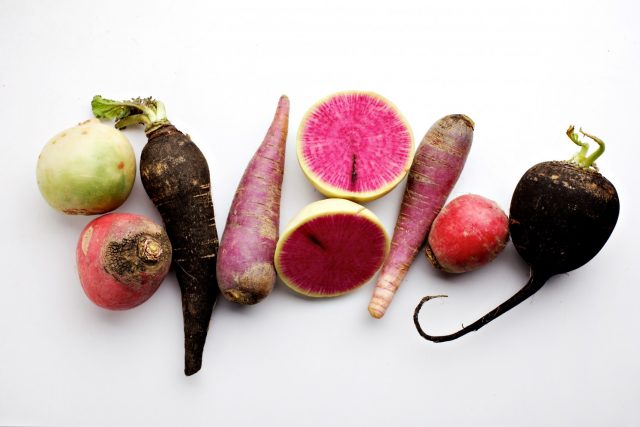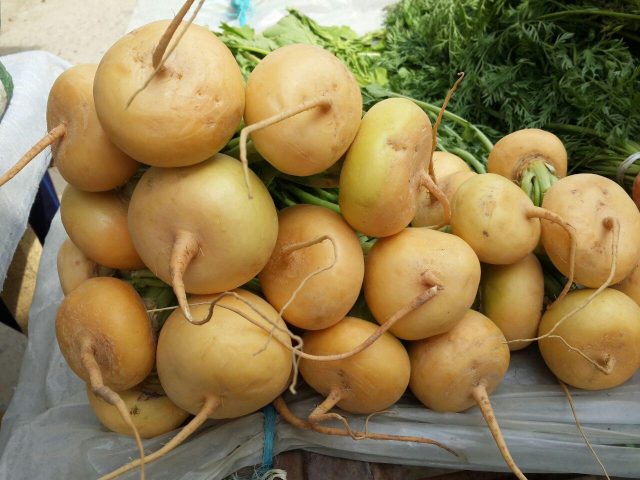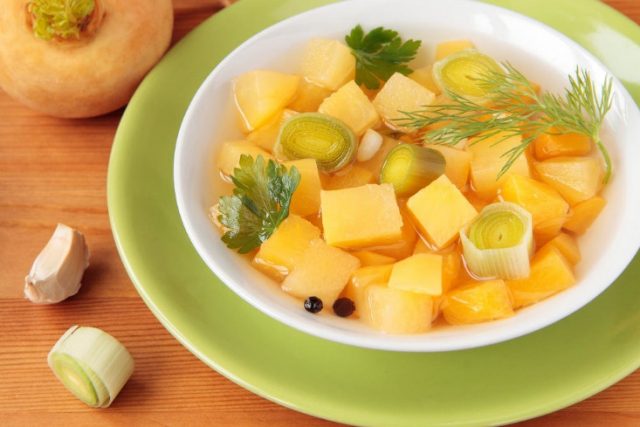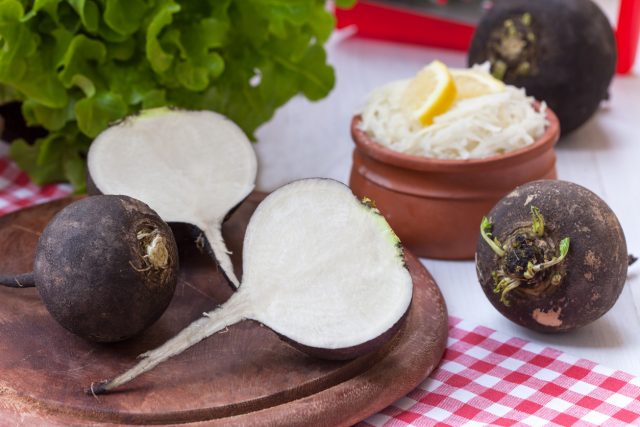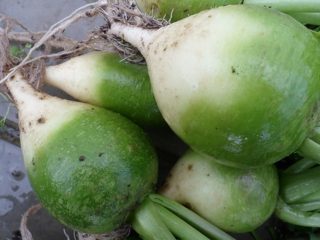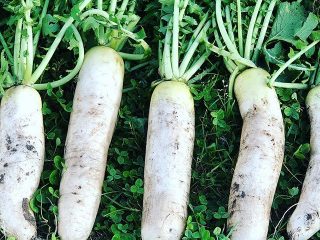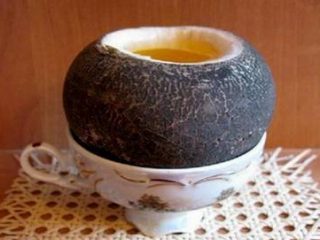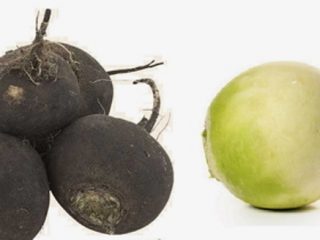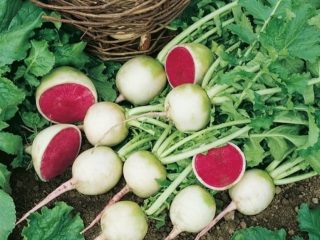Content
Turnips and radishes are similar in appearance, but this similarity will not deceive anyone who has at least once tasted the vegetables. Fleshy, juicy fruits are very healthy and nutritious, rich in vitamins and minerals, but still their use is different both in cooking and in traditional methods of treatment. The various properties and contraindications of crops require detailed consideration, because these two vegetables need to be prepared and used differently.
Are radishes and turnips the same thing?
Both vegetables belong to the cabbage family and have a fleshy, edible root. Root crops were cultivated several thousand years ago. Moreover, the first mentions of them are found in the culture of Ancient Greece and Egypt, and turnips were the basis of the diet of the Slavic peoples. Radish is still found in the wild in Europe, but there are no uncultivated varieties of turnip left in nature.
Belonging to the Cruciferous family, both crops have a similar two-year development cycle, in which the root crop is formed in the first season, and a stem with flowers and seeds is formed in the second. However, radish and turnip each constitute a separate genus, including up to several dozen varieties.
What do turnips and radishes look like?
Distant botanical relationships provide crops with a similar fruit shape.The edible thickening of the root is round in both cases. But in the case of radish, the fruit is often elongated or gradually thins towards the tip. There are varieties with spherical or cylindrical roots. Turnips always have a smooth, round shape with a characteristic flatness. From the photo of turnips and radishes you can get an idea of the main differences between vegetables in shape and color.
The Radish genus includes many varieties with different surface colors, but most often with white or slightly colored flesh. There are varieties with a bright pink center and light cream skin. The consistency of the fresh fruit is crispy and glassy. The peel of different varieties can be black, white, greenish or even pink and purple.
Turnips are always painted in light yellow tones. In some varieties the shade appears weaker, almost white. But the peel and pulp do not have sharp differences in color. The brightness of the yellow color indicates the content of carotenes in the fruit, so it may depend on soil fertility or lighting conditions.
During the growth period in the garden, the plants are also similar. The leaves grow in a bunch from a basal rosette and rise to a height of up to half a meter. But turnip foliage is elongated or heart-shaped. Radish most often has leaves that are dissected or divided into lobes.
What is the difference between a turnip and a radish?
There are many similarities between root crops in terms of tolerance to any soil and low maintenance requirements when growing. The ripening period of crops varies. Turnips are fast-growing, they are ready for consumption in 45 days. Radishes must ripen for more than 100 days.
The taste of vegetable crops is different. Radish varieties differ in the concentration of bitterness, but all have a distinct pungency. Turnips have a sweeter flavor and a more delicate texture.The differences between turnips and radishes determine their culinary uses.
Turnips, before the advent of potatoes, formed the basis for soups, porridges, and vegetable stews in Rus'. It was steamed, baked, boiled and eaten as a separate dish. The vegetable can be used raw, but is more suitable when cooked. When heat treated, turnips acquire a delicate, crumbly consistency and are combined with both salty and sweet tastes.
Radish, with its inherent sharpness and pungency, is a savory appetizer and a base for salads. It is often served fresh, chopped or finely grated. Heat treatment spoils the characteristic taste. Radishes are usually boiled or baked to prepare medicinal compositions.
How to distinguish turnips from radishes
Two similar crops are applicable for different purposes, so their characteristic differences should be highlighted to select the desired root crop for sale:
- Form. Oblong, pointed or rod-like in radishes and distinctly round, flattened (often with a depressed top) in turnips.
- Color. Various surface colors (from white to black), with a predominantly white center in radishes. Turnips are pale yellow, uniform throughout the flesh.
- Size. Both crops can form fruits of different weights, from 50 to 500 g, depending on growing conditions. But only turnips are able to grow up to 10 kg. Radish usually does not exceed 0.5 kg, which is considered a fairly large specimen.
It's even easier to distinguish turnips from their spicier cousin by taste. The sweetish-neutral taste of the yellow vegetable cannot be confused with the crispy, juicy pulp of radish with a distinct bitterness.
Which is healthier – turnip or radish?
Both vegetables are healthy and can be included in the diet to replenish the substances a person needs.In terms of calorie content, root vegetables are classified as dietary products: turnip has 32 kcal, and radish - 36 kcal per 100 g of edible part. Vegetables are rich in healthy fiber, about ¾ of them are light carbohydrates.
Root vegetables are rich in vitamin C. However, when heated, most of it is lost, so carotenes play an important role in the value of turnips, which, on the contrary, are easier to digest when heated. In its raw form, the vegetable is the leader in vitamin C content among root vegetables.
The sterol in the composition helps cleanse blood vessels of cholesterol deposits. The rare substance glucoraphanin is a unique anticancer element. Turnip contains plant analogues of antibiotics, which help inhibit the growth of fungi and some bacteria, and disinfect mucous membranes.
Valuable substances in turnips:
- B vitamins: especially high in pyridoxine (B6), folic and pantothenic acids (B9, B5);
- nicotinic acid (PP, NE);
- silicon, potassium, magnesium, calcium;
- cobalt, copper, manganese.
The beneficial effect of turnips on the body is manifested in the regulation of the gastrointestinal tract, bile production, providing nutrition to muscles (including the heart), maintaining strength and bone density. The properties of the vegetable to improve sleep and strengthen the nervous system are especially valued.
Radish also has a valuable composition, where the most significant concentrations are of the following substances:
- vitamins B5, B6, B9;
- vitamins K and PP;
- silicon, potassium, chlorine, magnesium;
- molybdenum, cobalt, iron, zinc.
The presence of bitter glycosides, as well as various essential oils, gives radish the property of stimulating the secretion of the stomach and gall bladder, which is useful for sluggish digestion, but undesirable for any disorders accompanied by high acidity, gastritis, ulcers. The strong effect of these active ingredients is used for rheumatism, radiculitis, and to reduce joint pain.
The active elements provide a tonic, vitaminizing, and immune-strengthening effect. The elasticity of blood vessels increases, atherosclerotic deposits are washed away. The expectorant and disinfectant properties of radish are used for any pathologies of the respiratory tract with cough, runny nose, and stagnation of thick sputum.
Despite the significant similarity in composition, the difference between turnip and radish in the effect on the body is significant. Thus, the yellow root vegetable is an excellent remedy for eliminating gastric and intestinal diseases, and radish is contraindicated for use in most of them.
During pregnancy, turnip is a means of supporting the mother's body and ensuring the development of the fetus. Due to its strong effect, it is recommended to limit radish during this period, and take it in moderation after childbirth to enhance lactation.
Both root vegetables contain elements that support heart function. But radish is not used after a heart attack or for serious cardiovascular pathologies. Turnip is able to calm the heart rate and has a gentle effect on blood vessels, therefore it is indicated for dietary nutrition for heart patients.
Conclusion
Turnips and radishes are similar in appearance, but are completely different in taste, method of use, and medicinal effects. The yellow vegetable can become a permanent, healthy product on the table, ensuring a healthy metabolism.Radish is used as a vitamin supplement to the diet, a spicy seasoning, and sometimes a strong medicine.
